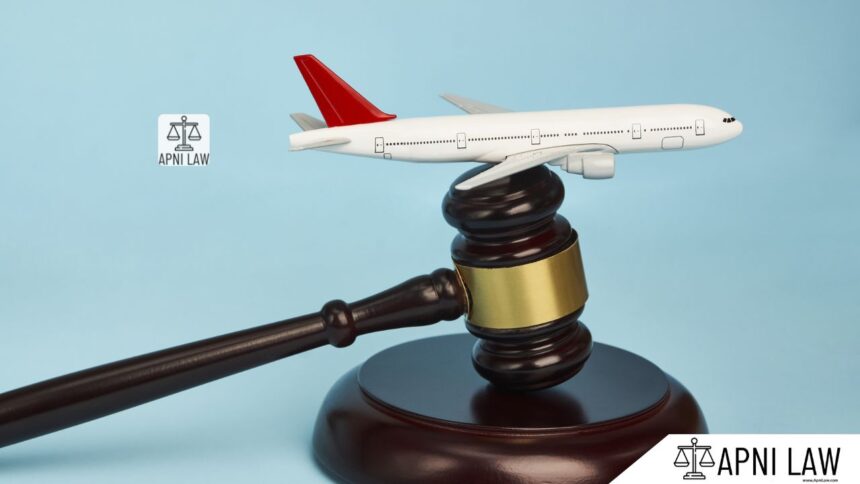This article is written by Amna Kabeer, student at the University of Calicut with a strong interest in the aviation sector. Passionate about simplifying complex legal developments, she aspires to build a career in aviation industry. For any feedback or queries, feel free to reach out to us through our official channel.
Introduction
The Bharatiya Vayuyan Adhiniyam, 2024 (Indian Aircraft Act, 2024) is a landmark legislation enacted by the Parliament of India to regulate and control various aspects of civil aviation. It replaces the Aircraft Act, 1934, aiming to modernize and streamline the governance of the aviation sector in India. The Act provides a comprehensive legal framework for the design, manufacture, maintenance, possession, use, operation, sale, export, and import of aircraft. It establishes key regulatory bodies, including the Directorate General of Civil Aviation (DGCA), the Bureau of Civil Aviation Security (BCAS), and the Aircraft Accidents Investigation Bureau (AAIB), to oversee safety, security, and accident investigations, respectively. The central government retains superintendence over these bodies, with the authority to issue directions and review their orders.
Role of DGCA Under the Aircraft Act, 1934
The Central Government established the Directorate General of Civil Aviation (DGCA) under the Aircraft Act, 1934. It now functions as a statutory body under the new legislation. The Director General of Civil Aviation, an officer appointed through notification in the Official Gazette, heads the DGCA. This officer holds the responsibility for overseeing all administrative activities within the DGCA.
Responsibilities of DGCA
One of its primary responsibilities is aviation safety oversight. The DGCA ensures that airlines, airports, and maintenance organizations comply with stringent safety norms.
The Act brings regulatory clarity by officially including the design, manufacture, and maintenance of aircraft under the DGCA’s jurisdiction. This move supports the growth of the Maintenance, Repair, and Overhaul (MRO) sector in India and promotes the government’s vision of Atmanirbhar Bharat. Another significant update is the DGCA’s new authority to issue the Radio Telephone Operator Restricted Certificates (RTORC), which were previously handled by the Department of Telecommunications. This consolidation simplifies the licensing process for pilots, aircraft engineers, and flight dispatchers.
In alignment with international obligations, the DGCA is also responsible for ensuring that India’s aviation regulations confirm to the Chicago Convention and the International Telecommunication Convention.
Furthermore, the Act empowers the DGCA to enforce aviation rules and impose strict penalties, including imprisonment of up to two years or fines up to ₹1 crore, for violations such as dangerous flying or carrying prohibited goods. To promote transparency and fair regulatory practices, an appellate mechanism has been introduced. Parties aggrieved by DGCA decisions can now appeal to the central government through a two-tier process.
Although the DGCA has expanded autonomy under the 2024 Act, it remains under the supervision of the central government, which retains the power to modify or review its orders. These updates make India’s civil aviation regulation more modern, efficient, and globally competitive, reinforcing the DGCA’s position as a crucial authority in ensuring safe and sustainable aviation.
Delegation of DGCA’s Powers
The Central Government holds the authority to delegate the powers of the DGCA to other officers or authorities. It must issue such delegations through a notification in the Official Gazette. This allows greater administrative flexibility and ensures efficient enforcement of aviation regulations.
Authority to Issue Directions by DGCA
The Director General of Civil Aviation, or any officer authorized by the government, may issue directions under the Act. These orders must align with the law and cover specific functions under Section 10(2) clauses (b), (e), (g), (i), (j), (k), (l), (m), (n), (o), (p), (q), (r), (s), (w), (zb), (zc), (zd), and (zf). Such directions may apply to individuals involved in using aerodromes, operating aircraft, managing air traffic control, maintaining aerodromes, handling communication and navigation systems, surveillance, air traffic management, and civil aviation security. These orders aim to safeguard India’s national security and ensure flight safety. Recipients of these directions must comply immediately.
Authority to Issue Directions by BCAS
The Director General of the Bureau of Civil Aviation Security (BCAS) or an authorized officer can also issue directions. These must conform to the provisions of the Aircraft Act and apply to clauses (i), (j), (o), (ze), and (zg) of Section 10(2). The directions target individuals engaged in using aerodromes, operating aircraft, managing air traffic control, maintaining aerodromes, and ensuring aviation security. The primary objective is to protect national security and aviation infrastructure from unlawful acts. Compliance with such directions is mandatory and immediate.
What Are The Regulatory Areas under Section 10(2) of the Bharatiya Vayuyan Adhiniyam, 2024?
The Bharatiya Vayuyan Adhiniyam, 2023, outlines specific areas where the Central Government can establish rules to ensure the safety, security, and efficiency of civil aviation in India. The relevant clauses are:
- Clause (b): Certification and airworthiness standards for aircraft.
- Clause (e): Licensing requirements for pilots, engineers, and air traffic controllers.
- Clause (g): Safety protocols for aircraft operations and inspections.
- Clause (i): Regulations pertaining to air traffic and navigation control.
- Clause (j): Operational guidelines for aerodrome usage.
- Clause (k): Standards for maintenance and repair of aircraft and components.
- Clause (l): Implementation of communication and surveillance systems.
- Clause (m): Navigation and air traffic management procedures.
- Clause (n): Provision of meteorological services for air navigation.
- Clause (o): Procedures for investigating aviation accidents.
- Clause (p): Handling and transportation of dangerous goods by air.
- Clause (q): Training and operational procedures for flight crews.
- Clause (r): Maintenance of records and reports related to air safety.
- Clause (s): Compliance with international aviation standards.
- Clause (w): Enforcement mechanisms for directions and penalties.
- Clause (zb): Environmental standards applicable to civil aviation.
- Clause (zc): Safety measures for passengers and crew.
- Clause (zd): Registration processes for aircraft.
- Clause (zf): General regulatory and safety functions.
- Clause (ze): Protection against acts of unlawful interference, such as hijacking or sabotage.
- Clause (zg): Coordination with other security and intelligence agencies.
Conclusion
The Bharatiya Vayuyan Adhiniyam, 2024 represents a significant step towards modernizing India’s civil aviation regulatory framework. By replacing the outdated Aircraft Act, 1934, it aligns the country’s aviation laws with contemporary standards and practices. The establishment of dedicated regulatory bodies ensures a structured approach to safety, security, and accident investigations, fostering a safer and more efficient aviation environment.











